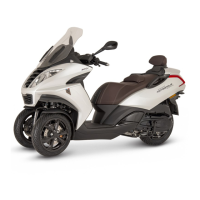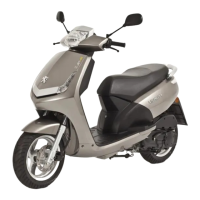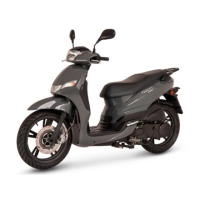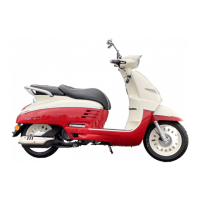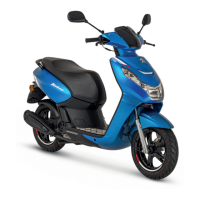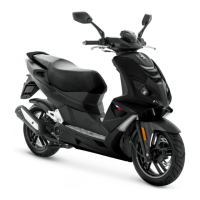Do you have a question about the PEUGEOT METROPOLIS ABS 2021 and is the answer not in the manual?
Introduction to the user manual and vehicle.
Essential safety precautions for operating the vehicle.
Specifications for vehicle weight and physical dimensions.
Details on engine type, capacity, power, and torque.
Fluid capacities, tyre sizes, and inflation pressures.
Information on the braking system and electrical components.
Location of VIN, engine number, and manufacturer's plate.
Details on tyre pressure labels and recommendations.
Specifies recommended fuel, engine oil, coolant, and grease.
Explains various symbols used throughout the manual.
Identifies main exterior parts of the vehicle.
Identifies further components and their locations.
Operation of starter, anti-tilting, lighting, and select buttons.
Operation of horn, indicators, beam, and exit buttons.
Operation of hazard lights and electric parking brake.
Description of the digital display, speedometer, and other instruments.
Location of warning lights on the instrument panel.
Explains all warning lights, their causes, and recommended actions.
Information on Date/Clock, Fuel Gauge, and Speedometer.
Details on Engine Temperature and Oil Pressure warning lights.
Information on Tripmeter, average consumption, and autonomy.
Data on Battery voltage, outside temperature, and maintenance.
Menu options for trip reset and display personalization.
Menu options for language selection and unit settings.
Options for display units and backlighting settings.
Access to Bluetooth, Call, Message, and Navigation features.
Step-by-step instructions for pairing a Bluetooth telephone.
Display of ETA, distance, road names, and current location.
Information on next direction, current road, and route.
General app information, languages, and phone compatibility.
Steps for creating an account and recovering a password.
Accessing profile, vehicle info, and maintenance reminders.
Functionality to save the vehicle's current location.
Settings for map supplier, strategy, and route avoidance.
Using the search bar, saved addresses, and compass.
Real-time display of vehicle speed, engine speed, temp, and voltage.
Displays trip data, fuel, autonomy, consumption, and diagnostics.
Managing linked scooters and instrument panel settings.
Installing or uninstalling regional navigation maps.
How the smart key interacts with the vehicle.
Using the rotating knob for starting, stopping, and steering lock.
Procedures for when the smart key is not recognized.
Process for registering new or replacement smart keys.
Accessing the glove box and other storage compartments.
Instructions for adjusting the windshield height.
Procedure for adjusting the handlebar tilt.
Location and use of the utility hanger and USB power socket.
Details on opening, closing, and space within the rear compartment.
Operation of storage compartment lighting and backrest adjustment.
Adjusting suspension based on vehicle load.
Adjusting shock absorber compression and rebound.
Key checks to perform before starting the vehicle.
Advice on eco mode driving and warnings for flooded roads.
Detailed inspection checklist for fuel, oil, brakes, tyres, etc.
Procedures for starting the engine and beginning to drive.
Details on the ABS braking system and brake lever operation.
Instructions for fueling and the engine break-in period.
Procedure for stopping the vehicle and switching off the engine.
Guidelines for parking on flat ground, slopes, and using the stand.
Procedure to open compartments with a flat battery.
Manually unlocking anti-tilting and parking brake systems.
Maintenance schedule, dealer advice, and cleaning the bodywork.
Inspection and replacement procedures for the spark plug.
Procedure and frequency for checking the engine oil level.
Recommended procedure for draining and refilling engine oil.
Procedure for replacing the engine oil filter cartridge.
How to check and top up the engine coolant level.
Maintenance of the air filter and checking throttle cable play.
Checking tyre pressure, wear limits, and replacement advice.
Procedure for inspecting the wear on brake pads.
How to check brake fluid levels and reservoir.
Precautions for handling battery acid and avoiding sparks.
How to preserve battery charge during long periods of non-use.
Step-by-step guide for removing and refitting the battery.
Specific care instructions for maintenance-free batteries.
Procedures and precautions for safely charging the battery.
Diagram and list of fuse locations, ratings, and protected circuits.
Instructions and precautions for replacing a faulty fuse.
Procedure for replacing the number plate light bulb.
How to adjust the aim of the headlights.
Introduction to the user manual and vehicle.
Essential safety precautions for operating the vehicle.
Specifications for vehicle weight and physical dimensions.
Details on engine type, capacity, power, and torque.
Fluid capacities, tyre sizes, and inflation pressures.
Information on the braking system and electrical components.
Location of VIN, engine number, and manufacturer's plate.
Details on tyre pressure labels and recommendations.
Specifies recommended fuel, engine oil, coolant, and grease.
Explains various symbols used throughout the manual.
Identifies main exterior parts of the vehicle.
Identifies further components and their locations.
Operation of starter, anti-tilting, lighting, and select buttons.
Operation of horn, indicators, beam, and exit buttons.
Operation of hazard lights and electric parking brake.
Description of the digital display, speedometer, and other instruments.
Location of warning lights on the instrument panel.
Explains all warning lights, their causes, and recommended actions.
Information on Date/Clock, Fuel Gauge, and Speedometer.
Details on Engine Temperature and Oil Pressure warning lights.
Information on Tripmeter, average consumption, and autonomy.
Data on Battery voltage, outside temperature, and maintenance.
Menu options for trip reset and display personalization.
Menu options for language selection and unit settings.
Options for display units and backlighting settings.
Access to Bluetooth, Call, Message, and Navigation features.
Step-by-step instructions for pairing a Bluetooth telephone.
Display of ETA, distance, road names, and current location.
Information on next direction, current road, and route.
General app information, languages, and phone compatibility.
Steps for creating an account and recovering a password.
Accessing profile, vehicle info, and maintenance reminders.
Functionality to save the vehicle's current location.
Settings for map supplier, strategy, and route avoidance.
Using the search bar, saved addresses, and compass.
Real-time display of vehicle speed, engine speed, temp, and voltage.
Displays trip data, fuel, autonomy, consumption, and diagnostics.
Managing linked scooters and instrument panel settings.
Installing or uninstalling regional navigation maps.
How the smart key interacts with the vehicle.
Using the rotating knob for starting, stopping, and steering lock.
Procedures for when the smart key is not recognized.
Process for registering new or replacement smart keys.
Accessing the glove box and other storage compartments.
Instructions for adjusting the windshield height.
Procedure for adjusting the handlebar tilt.
Location and use of the utility hanger and USB power socket.
Details on opening, closing, and space within the rear compartment.
Operation of storage compartment lighting and backrest adjustment.
Adjusting suspension based on vehicle load.
Adjusting shock absorber compression and rebound.
Key checks to perform before starting the vehicle.
Advice on eco mode driving and warnings for flooded roads.
Detailed inspection checklist for fuel, oil, brakes, tyres, etc.
Procedures for starting the engine and beginning to drive.
Details on the ABS braking system and brake lever operation.
Instructions for fueling and the engine break-in period.
Procedure for stopping the vehicle and switching off the engine.
Guidelines for parking on flat ground, slopes, and using the stand.
Procedure to open compartments with a flat battery.
Manually unlocking anti-tilting and parking brake systems.
Maintenance schedule, dealer advice, and cleaning the bodywork.
Inspection and replacement procedures for the spark plug.
Procedure and frequency for checking the engine oil level.
Recommended procedure for draining and refilling engine oil.
Procedure for replacing the engine oil filter cartridge.
How to check and top up the engine coolant level.
Maintenance of the air filter and checking throttle cable play.
Checking tyre pressure, wear limits, and replacement advice.
Procedure for inspecting the wear on brake pads.
How to check brake fluid levels and reservoir.
Precautions for handling battery acid and avoiding sparks.
How to preserve battery charge during long periods of non-use.
Step-by-step guide for removing and refitting the battery.
Specific care instructions for maintenance-free batteries.
Procedures and precautions for safely charging the battery.
Diagram and list of fuse locations, ratings, and protected circuits.
Instructions and precautions for replacing a faulty fuse.
Procedure for replacing the number plate light bulb.
How to adjust the aim of the headlights.
| Displacement | 399cc |
|---|---|
| Fuel System | Electronic Fuel Injection |
| Transmission | Automatic |
| Front Suspension | Telescopic forks |
| Rear Tire | 140/70-14 |
| Brakes | ABS |
| Torque | 28.1 lb-ft (38.1 Nm) @ 5750 rpm |
| Rear Brake | 240 mm disc, ABS |
| Fuel Capacity | 13 liters |
| Seat Height | 30.7 inches (780 mm) |
| Wheelbase | 1, 550 mm |
| Rear Suspension | Twin shock absorbers |

